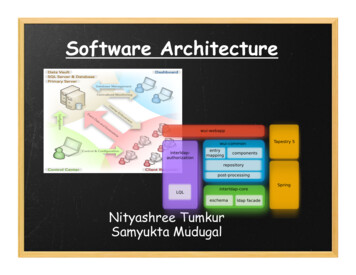
Transcription
Software ArchitectureNityashree TumkurSamyukta Mudugal
What is Software Architecture?It is the structure of the system whichconsists of software components, theexternally visible properties of thosecomponents and the relationship betweenthem.
Features Every System has its own architecture but they arenot identical. Software architecture and its description aredifferent. The different stakeholders are1. Users of the System2. Acquirers of the System3. Developers of the System4. Maintainers of the System
Architecture Centered Life Cycle
Views Used in Software Architecture Software architecture is organised in views which areanalogous different types of blueprints made in buildingarchitecture. Different views are:o Component and Connector view.o Decomposition view.o Allocation view
Component - Connector View
Decomposition View
AllocationViewImplementationviewDeployment View
Architectural Styles Pipes & FiltersClient- ServerEvent DrivenHierarchical LayerData SharingObject Oriented
Pipes & Filters Very Simple yet powerful and robust architecture. Examples:1. Unix Programs2. Compilers Components1. Pipe2. Filter3. Pump4. Sink
Pipes & Filters StyleRecursive Technique
Relationship between different filterprocesses.
Digital Communication SystemWeb Application
Another Example
Client Server StyleDistributed Application Architecture thatpartitions the tasks into service providers andservice requesters
Advantages Roles and responsibilities of computing systems to bedistributed among independent computers known to eachother only through the network. All the data is stored in the server which have bettersecurity controls. Caters to multiple different clients with differentcapabilities. Data updates are easier and faster as Data iscentralized.
Disadvantages As the number of client requests increases the serverbecomes overloaded Client - Server Architecture lacks the robustness ofPeer to Peer Architecture.Lets look at this architectureimplementation in ACME.
Client - Server in ACME
Event-Driven Architecture Architecture pattern that promotes production,detection, consumption of and reaction to events. It consists of event emitters and event consumers. Sinks have the responsibility of applying a reaction assoon as the event is presented.Systems have certain goal under the control ofsome message mechanism and the subsystemcollaborates with each other to achieve system'sultimate goal.
Event - Driven Architecture
Hierarchical Layer It is a layered architecture. Each layer has 2 roles:1. Provide services for the upper layers.2. Call lower layers functions. Conceptual layer system model:
Advantages of Layering Supports gradual abstraction in the system designprocess. Layer system has good extendability. Layer style supports software reuse.
Example of a layered architecture: ISO/OSInetwork 7- layer architecture
Data Sharing Also called repository style. System has 2 components:1. Central data unit component.2. Set of relatively dependent components. Central data unit called the repository sharesinformation with all the other units. There are differences in the information exchangepatterns. Thus there are 2 main control stratergies to deal withthese information exchange patterns.
Black-board type repository modelThe components:ks-knowledge sources,Central Data Unit,Control Unit.
Example: Expert system
Object Oriented The key features are:o Data Abstraction.o Modularization.o Information encapsulation.o Inheritance.o Polymorphism. Objects in the problem are first recognized, then properclasses are constructed to represent these objects. Java - Object Oriented Programming, C - Proceduralprogramming.
Example of Object Oriented Architecture:Described using a UML diagram.
Architecture Description Languages Computer language used to describe the softwarearchitecture. Shaw and Garland's description for ADL's includes1. Components.2. Operators.3. Patterns.4. Closure.5. Specification. Different ADL's existing: ACME, AADL, Darwin,WRIGHT.
What makes a language an ADL? Be suitable for communicating an architecture to all thestake holders. Support the tasks of architecture creation, refinementand validation. Provide the ability to represent most commonarchitectural styles. Support analytical capabilities. Provide quick generating prototype implementations.
Darwin Declarative Language. Describes the organization of software in terms ofcomponents, their interfaces and their binding componentsbetween them. Provides general purpose notations for specifying the structureof the system. Focuses on specification of distributed software system. Supports the specifications of dynamic structures.
Client Server System in Darwin
Filter Component in Darwin
Conclusion-I Common attribute in all the architectural slides extendibility. Good software - closed for change, open for extension. Each style has its good quality attributes at the cost ofsacrificing other quality attributes.o Pipes and filters style has bad interactivity whileevent driven style has good support for userinteractivity.o In event driven style its hard to share common data,while repositories has advantage of data sharing.
Conclusion-II Maximum benefit of software architectural styles canbe achieved by the integration of different styles.
References Software Architecture - Zheng Qin, Jiankuan Xing,Xiang Zheng. Garfixia Software Architecture - Patrick Van Bergen. Art of Software Architecture: Design methods andTechniques - S.T. Albin.
Event-Driven Architecture Architecture pattern that promotes production, detection, consumption of and reaction to events. It consists of event emitters and event consumers. Sinks have the responsibility of applying a reaction as soon as the event is
